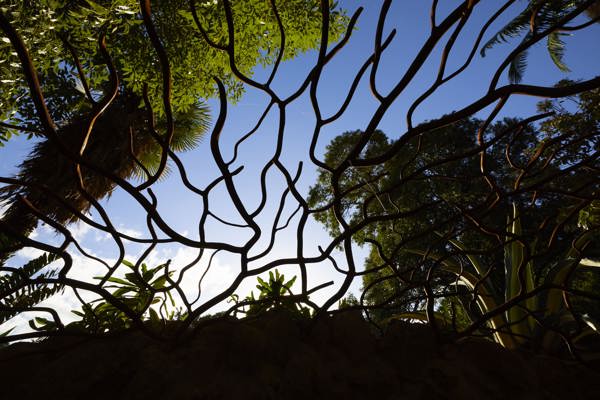
Rebecca Miller
Research Scientist (Seed Science)
Rebecca Miller Joined RBGV as a seed scientist in October 2020 and will be conducting research on native plant seeds, the imposition and alleviation of dormancy, the stimulation of germination, and environmental tolerance thresholds of native species. She is a plant ecophysiologist whose research experience includes the physiological and biochemical responses of plants to the environment, and the chemical ecology of plant defence and plant-pollinator interactions. Rebecca is also an experienced teacher across many areas of plant biology including horticulture, plant propagation and establishment.
Publications
Ritmejeryté, E., Miller, R.E., Bayly, M.J., Boughton, B.A. (in press). Visualisation of cyanogenic glycosides in floral tissues. In: Beale, D.J., Jones, O.A.H., Warden, A.C. (eds.) Environmental Metabolomics: Approaches, Challenges and Future Perspectives. Elsevier, Netherlands.
Bramley-Alves J., King D.H., Robinson S.A., Miller R.E. (2014) Dominating the Antarctic Environment: Bryophytes in a Time of Change. In: Hanson D., Rice S. (eds.) Photosynthesis in Bryophytes and Early Land Plants. Advances in Photosynthesis and Respiration (Including Bioenergy and Related Processes), vol 37. Springer, Dordrecht. DOI: 10.1007/978-94-007-6988-5_17
Gleadow, R.M., Bjarnholt, N., Jørgensen, K., Fox, J., Miller, R.E. (2010). Cyanogenic Glycosides. Detection, identification and quantitative measurement. Chapter 12. In: Narwal, S.S., Szajdak, L. Sampietro, D.A. (eds.): Research Methods in Plant Science Volume 1. Soil Allelochemicals. Published by International Allelopathy Foundation. pp.283–310. (Series ISBN: 1-933699-64-7; Vol. ISBN: 1-933699-65-5)
McKendrick, S.A., Ede, F.J., Miller, R.E., Greet. J. 2022. Pre-emergence processes limit seedling recruitment in two direct seeded Acacia spp. Forest Ecology and Management 1(505): 119912. DOI: 10.1016/j.foreco.2021.119912
Waymouth, V., Miller, R.E., Kasel, S., Ede, F., Bissett, A., Aponte, C. 2022. Riparian fungal communities respond to land‑use mediated changes in soil properties and vegetation structure. Plant and Soil 475:491-513. DOI: 10.1007/s11104-022-05383-8
Sayers, T.D.J., Johnson, K.L., Steinbauer, M.J., Farnier, K., Miller, R.E. 2021. Divergence in floral scent and morphology but not thermogenic traits associated with pollinator shift in two brood-site mimicking Typhonium (Araceae) species. Annals of Botany 128(3): 261-280. DOI: 10.1093/aob/mcab044
Guo, B., Arndt, S.A., Miller, R.E., Farrell, C. 2021. Are succulence or trait combinations related to plant survival on hot and dry green roofs? Urban Forestry and Urban Greening 64: 127248. DOI: 10.1016/j.ufug.2021.127248
Williams, N.S.G., Bathgate, R.S., Farrell, C., Lee, K.E., Szota, C., Bush, J., Johnson, K.A., Miller, R.E., Pianella, A., Sargent, L.D., Schiller, J., Williams, K.J.H., Rayner, J.P. 2021. Ten years of greening a wide brown land: A synthesis of Australian green roof research and roadmap forward. Urban Forestry and Urban Greening 62: 127179 DOI:10.1016/j.ufug.2021.127179
Waymouth, V., Miller, R.E., Kasel, S., Ede, F., Bissett, A., Aponte, C. 2021. Soil Bacterial Community Responds to Land-Use Change in Riparian Ecosystems. Forests 12: 157. DOI: 10.3390/f12020157 (part of the Special Issue Restoring Forest Landscapes: Impact on Soil Properties and Functions)
Bermúdez-Contreras, A.I., Ede, F., Waymouth, V., Miller, R.E., Aponte, C. 2020. Revegetation technique changes root mycorrhizal colonisation and root fungal communities: the advantage of direct seeding over transplanting tube-stock in riparian ecosystems. Plant Ecology 221: 813–828. DOI: 10.1007/s11258-020-01031-2
Waymouth, V., Miller, R.E., Ede, F., Bissett, A., Aponte, C. 2020. Variation in soil microbial communities: elucidating relationships with vegetation and soil properties, and testing sampling effectiveness. Plant Ecology 221: 837–851. DOI: 10.1007/s11258-020-01029-w
Ritmejeryté, E., Boughton, B.A., Bayly, M.J., Miller, R.E. 2020. Unique cyanogenic glycoside localisation in pollen and stigmatic cells in the genus Lomatia (Proteaceae). Annals of Botany 126(3): 387–400. DOI: 10.1093/aob/mcaa038
Sayers, T.D.J., Steinbauer, M.J., Farnier, K., Miller, R.E. 2020. Dung mimicry in Araceae: explaining floral trait and pollinator divergence in a Typhonium complex and a related species. Botanical Journal of the Linnean Society 193(3): 375–401. DOI: 10.1093/botlinnean/boaa021
Cooper, W.E., Crayn, D.M., Nauheimer, L., Zich, F.A., Miller, R.E., Harrison, M. 2019. A review of Austrocallerya and Pongamia (Leguminosae subfamily Papilionoideae) in Australia, and the description of a new monotypic genus, Ibatiria. Australian Systematic Botany 32(4): 363–384. DOI: 10.1071/SB18039
Williams, K.J.H., Lee, K.E., Sargent, L., Johnson, K.A., Rayner, J., Farrell, C., Miller, R.E., Williams, N.S.G. 2019. Appraising the psychological benefits of green roofs for city residents and workers. Urban Forestry & Urban Greening 44: 126399. DOI: 10.1016/j.ufug.2019.126399
Ritmejeryté, E., Boughton, B.A., Bayly, M.J., Miller, R.E. 2019. Divergent responses of above and below ground chemical defence to nitrogen and phosphorus supply in waratahs (Telopea speciosissima) Functional Plant Biology 46: 1134–1145. DOI: 10.1071/FP19122
Sayers, T.D.J., Steinbauer, M.J., Miller, R.E. 2019. Visitor or vector? The extent of rove beetle (Staphylinidae: Coleoptera) pollination and floral interactions. Arthropod-Plant Interactions 13: 685–701. DOI: 10.1007/s11829-019-09698-9
Waterman, M.J., Bramley-Alves, J., Miller, R.E., Keller, P.A., Robinson, S.A. 2018. Photoprotection enhanced by red cell wall pigments in three East Antarctic mosses. Biological Research (Special Antarctic Issue) 51: 49. DOI: 10.1186/s40659-018-0196-1
Robinson, S.A., King, D.H., Bramley-Alves, J., Waterman, M.J., Ashcroft, M.B., Wasley, J., Turnbull, J.D., Miller, R.E., Ryan-Colton, E., Benny, T., Mullany, K., Clarke, L.J., Barry, L.A., Hua, Q. 2018. Rapid change in East Antarctic terrestrial vegetation in response to regional drying. Nature Climate Change 8: 879–884. DOI: 10.1038/s41558-018-0280-0
Smith, M.G., Arndt, S.K., Miller, R.E., Kasel, S., Bennett, L.T. 2018. Trees use more non-structural carbohydrate reserves during epicormic than basal resprouting. Tree Physiology 38(12): 1779–1791. DOI: 10.1093/treephys/tpy099
Fernando, D.R., Lynch, J.P., Reichman, S.M., Clark, G.J., Miller, R.E., Doody, T.M. 2018. Inundation of a floodplain lake woodlands system: nutritional profiling and benefit to mature Eucalyptus largiflorens (Black Box) trees. Wetlands Ecology and Management 26: 961–975. DOI: 10.1007/s11273-018-9623-x
Smith, M., Miller, R.E., Kasel, S., Arndt, S., Bennett, L. 2018. Whole-tree distribution and temporal variation of non-structural carbohydrates in broadleaf evergreen trees. Tree Physiology 38(4): 570–581. DOI: 10.1093/treephys/tpx141
Brown, A.L., Cavagnaro, T.R., Gleadow, R., Miller, R.E. 2016. Interactive effects of temperature and drought on cassava growth and toxicity: implications for food security? Global Change Biology 22 (10): 3461–3473. DOI: 10.1111/gcb.13380
Miller, R.E., Gleadow, R.M., Cavagnaro, T.C. 2014. Age versus stage: does ontogeny modify the effect of phosphorus and arbuscular mycorrhizas on above- and below-ground defence in forage sorghum. Plant Cell and Environment 37: 929–42. DOI: 10.1111/pce.12209
Miller, R.E., Tuck, K.L. 2013. Reports on the distribution of aromatic cyanogenic glycosides in Australian tropical rainforest tree species of the Sapindaceae and Lauraceae. Phytochemistry 92: 146–152. DOI: 10.1016/j.phytochem.2013.04.007
Miller, R.E., Tuck, K.L. 2013. The rare cyanogen proteacin, and dhurrin, from Polyscias australiana, a tropical Araliaceae. Phytochemistry 93:210–215. DOI: 10.1016/j.phytochem.2013.03.004
Vandegeer, R., Miller, R.E., Bain, M., Gleadow, R.M., Cavagnaro, T.R. 2013. Drought adversely affects yield and nutritional quality of cassava (Manihot esculenta Crantz). Functional Plant Biology 40: 195–200. DOI:10.1071/FP12179
Rosenthal, D.M., Slattery, R.A., Miller, R.E., Grennan, A.K., Gleadow, R.M., Cavagnaro, T.R., Fauquet, C.M., Ort, D.R. 2012. Cassava about-FACE: Greater than expected yield stimulation of cassava (Manihot esculenta) by future CO2 levels. Global Change Biology 18: 2661–2675. DOI: 10.1111/j.1365-2486.2012.02726.x
Burns, A.E., Gleadow, R.M., Zacarias, A.M., Cuambe, C.E., Miller, R.E., Cavagnaro, T.C. 2012. Variations in chemical composition of cassava (Manihot esculenta Crantz) leaves and tuberous roots as affected by genotypic and environmental variation. Journal of Agricultural and Food Chemistry 60: 4946–4956. DOI: 10.1021/jf2047288
Miller, R.E., Grant, N.M., Watling, J.R., Giles, L., Ribas-Carbo, M., Berry, J., Robinson, S.A. 2011. In the heat of the night – alternative pathway respiration drives thermogenesis in Philodendron bipinnatifidum. New Phytologist 189: 1013–1026. DOI: 10.1111/j.1469-8137.2010.03547.x
Cavagnaro, T.R., Gleadow, R.M., Miller, R.E. 2011. Viewpoint: plant nutrient acquisition and utilisation in a high CO2 world. Functional Plant Biology 38: 87–96. DOI: 10.1071/FP10124
Grant, N.M., Miller, R.E., Watling, J.R., Robinson, S.A. 2010. Distribution of thermogenic activity in floral tissues of Nelumbo nucifera. Functional Plant Biology 37: 1085–1095. DOI: 10.1071/FP10024
Miller, R.E., Watling, J.R., Robinson, S.A. 2009. Functional transition in the floral receptacle of the sacred lotus (Nelumbo nucifera): from thermogenesis to photosynthesis. Functional Plant Biology 36: 471–480. DOI: 10.1071/FP08326
Watling, J.R., Grant, N.M., Miller, R.E., Robinson, S.A. 2008. Mechanisms of thermoregulation in plants. Plant Signaling and Behavior 3: 595–597. DOI: 10.4161/psb.3.8.6341
Miller, R.E., Woodrow, I.E. 2008. Resource availability and the abundance of an N-based defense in Australian tropical rainforests. Ecology 89: 1503–1509. DOI: 10.1890/07-0335.1
Webber, B.L., Miller, R.E. 2008. Gynocardin from Baileyoxylon lanceolatum and a revision of cyanogenic glycosides in Achariaceae. Biochemical Systematics and Ecology 36: 545–553. DOI: 10.1016/j.bse.2008.03.011
Grant, N.M., Miller, R.E., Watling, J.R., Robinson, S.A. 2008. Synchronicity of thermogenic activity, alternative pathway respiratory flux, AOX protein content and carbohydrates in receptacle tissues of sacred lotus during floral development. Journal of Experimental Botany 59: 705–714. DOI: 10.1093/jxb/erm333
Webber, B.L., Miller, R.E., Woodrow, I.E. 2007. Constitutive polymorphic cyanogenesis in the Australian rainforest tree, Ryparosa kurrangii (Achariaceae) Phytochemistry 15: 2068–2074. DOI: 10.1016/j.phytochem.2007.04.038
Simon, J., Miller, R.E., Woodrow, I.E. 2007. Variation in defence strategies in two species of the genus Beilschmiedia across nutrient and rainfall gradients. Plant Biology 9: 152–157. DOI: 10.1055/s-2006-924537
Miller, R.E., Stewart, M., Capon, R.J., Woodrow, I.E. 2006. A galloylated cyanogenic glycoside from the Australian rainforest endemic Elaeocarpus sericopetalus. Phytochemistry 67: 1365–1371. DOI: 10.1016/j.phytochem.2006.03.022
Miller, R.E., Jensen, R., Woodrow, I.E. 2006. Frequency of cyanogenesis in Australian tropical rainforests. Annals of Botany 97: 1017–1044. DOI: 10.1093/aob/mcl048
Miller, R.E., Simon, J., Woodrow, I.E. 2006. Cyanogenesis in the Australian tropical rainforest endemic Brombya platynema (Rutaceae): chemical characterisation and polymorphism. Functional Plant Biology 33: 477–486. DOI: 10.1071/FP05305
Miller, R.E., McConville, M.J., Woodrow, .IE. 2006. Cyanogenic glycosides from the rare Australian endemic rainforest tree Clerodendrum grayi (Lamiaceae). Phytochemistry 67:43–51. DOI: 10.1016/j.phytochem.2005.09.038
Miller, R.E., Gleadow, R.M., Woodrow, I.E. 2004. Cyanogenesis in tropical Prunus turneriana: characterisation, variation and response to low light. Functional Plant Biology 31(5): 491–503. DOI: 10.1071/FP03218
Lovelock, C.E., Miller, R. 2002. Heterogeneity in inoculum potential and effectiveness of arbuscular mycorrhizal fungi. Ecology 83: 823–832. DOI: 10.1890/0012-9658(2002)083[0823:HIIPAE]2.0.CO;2
Miller, R., Sayers, T., Farnier, K., Steinbauer, M. 2017. Fragrance of a Hot Braeside Celebrity: why was it so appealing to blowflies? The titan arum – an example of the fascinating phenomenon of floral heating. Botanic News, Winter Edition, 18-21.

